Development, Calibration, and Validation of a Simulation Model for Indoor Temperature Prediction and HVAC System Fault Detection
Abstract
1. Introduction
1.1. Related Work
1.2. Contribution and Structure
- TRNSYS 18 software was used to develop a room-level simulation model of a hotel building in Zagreb, Croatia, and its HVAC (fan coil) system. Each room was set up as a separate thermal zone with appropriate boundary conditions and designed using the Google SketchUp 3D 2021 tool. To simplify and speed up the simulations, the model was created for a single room and applied to all rooms with similar physical characteristics by changing the room-specific parameters. In this way, the accuracy and reliability of the model in predicting indoor temperatures was increased relatively quickly through its calibration and validation with a genetic algorithm. The sensitivity analysis identified the most influential building and HVAC operating parameters, which were later used in the calibration process. Python scripts were developed to automatically create and run new simulations and process the results. Summer and winter seasons were considered, and the performances of the original (baseline) model and the calibrated model were compared.
- The simulations were fed with five-minute samples of real data collected over several years from the smart-room system installed in the hotel and integrated with the central building automation and control system. The data included temperature control logic, room occupancy, window opening, HVAC system status, and operating mode in each hotel room. Incorporating all of this data made developing the model challenging, but its accuracy is within the acceptable limits of the VDI, ASHRAE, and IPMVP guidelines. It has been shown to be applicable to any room in the building with similar characteristics but specific input parameters.
- The developed model has been used to detect anomalies associated with the operation of fan coil units in the rooms. It has successfully revealed the main anomalies in the system. However, further tests and diagnostics need to be performed to confirm the anomalies and their real causes. As a next step, the model should help develop more advanced automatic fault detection and diagnosis routines based on machine learning techniques that can be implemented in the building’s smart-room system in the future.
2. Materials and Methods
2.1. Building Description
2.2. HVAC System and Control Logic
2.3. Data Gathering
2.4. Simulation Model Development and Calibration
2.4.1. Thermal Zone Modeling
2.4.2. Simulation Model
- ROOM DATA contains room-specific information on setpoint temperature, occupancy, window status, HVAC status, and HVAC mode;
- MANUAL affects the HVAC system by setting the FCU fan speed desired by guests;
- NEIGHBOR ROOMS inputs the recorded temperatures of adjacent rooms and the design temperatures of public areas into the model to create boundary conditions for heat exchange with these spaces;
- WEATHER is used to create ambient conditions for the model.
2.4.3. Model Evaluation
- ASHRAE: cvRMSE 30% and nMBE 10%;
- IPMVP: cvRMSE 20% and nMBE 5%.
2.4.4. Calibration Process
2.5. Fault Detection in an HVAC System
3. Results and Discussion
4. Conclusions
Author Contributions
Funding
Data Availability Statement
Conflicts of Interest
Abbreviations
| ASHRAE | American Society of Heating, Refrigerating and Air Conditioning Engineers |
| FCU | Fan Coil Unit |
| GHG | Greenhouse Gas |
| HVAC | Heating, Ventilation, and Air Conditioning |
| IDA ICE | IDA Indoor Climate and Energy |
| IPMVP | International Performance Maintenance and Verification Protocol |
| nZEB | Nearly Zero Energy Building |
| TRNSYS | Transient System Simulation Tool |
| cvRMSE | Coefficient of Variation of the Root Mean Squared Error |
| MAE | Mean Absolute Error |
| MBE | Mean Bias Error |
| nMBE | Normalized Mean Bias Error |
| RMSE | Root Mean Squared Error |
References
- International Energy Agency (IEA). Buildings; IEA: Paris, France, 2022. Available online: https://www.iea.org/reports/buildings (accessed on 13 April 2023).
- International Energy Agency (IEA). Promoting Energy Efficiency Investments: Case Studies in the Residential Sector; OECD/IEA and AFD: Paris, France, 2008.
- Mariano-Hernández, D.; Hernández-Callejo, L.; Zorita-Lamadrid, A.L.; Duque-Perez, O.; García, F.S. A Review of Strategies for Building Energy Management System: Model Predictive Control, Demand Side Management, Optimization, and Fault Detect & Diagnosis. J. Build. Eng. 2021, 33, 101692. [Google Scholar] [CrossRef]
- Drgoňa, J.; Arroyo, J.; Figueroa, I.C.; Blum, D.H.; Arendt, K.; Kim, D.; Ollé, E.P.; Oravec, J.; Wetter, M.; Vrabie, D.; et al. All You Need to Know about Model Predictive Control for Buildings. Annu. Rev. Control 2020, 50, 190–232. [Google Scholar] [CrossRef]
- Zakula, T.; Armstrong, P.R.; Norford, L.K.; Norford, L.K. Modeling Environment for Model Predictive Control of Buildings. Energy Build. 2014, 85, 549–559. [Google Scholar] [CrossRef]
- Yao, Y.; Shekhar, D.K. State of the Art Review on Model Predictive Control (MPC) in Heating Ventilation and Air-Conditioning (HVAC) Field. Build Environ. 2021, 200, 107952. [Google Scholar] [CrossRef]
- Matetić, I.; Štajduhar, I.; Wolf, I.; Ljubic, S. A Review of Data-Driven Approaches and Techniques for Fault Detection and Diagnosis in HVAC Systems. Sensors 2023, 1, 1. [Google Scholar] [CrossRef] [PubMed]
- Cacabelos, A.; Eguía, P.; Febrero, L.; Granada, E. Development of a new multi-stage building energy model calibration methodology and validation in a public library. Energy Build. 2017, 146, 182–199. [Google Scholar] [CrossRef]
- Yu, J.; Chang, W.-S.; Dong, Y. Building Energy Prediction Models and Related Uncertainties: A Review. Buildings 2022, 12, 1284. [Google Scholar] [CrossRef]
- Guyot, D.; Giraud, F.; Simon, F.; Corgier, D.; Marvillet, C.; Tremeac, B. Overview of the Use of Artificial Neural Networks for Energy-related Applications in the Building Sector. Int. J. Energy Res. 2019, 43, 6680–6720. [Google Scholar] [CrossRef]
- Delač, B.; Pavković, B.; Lenić, K.; Mađerić, D. Integrated Optimization of the Building Envelope and the HVAC System in NZEB Refurbishment. Appl. Therm. Eng. 2022, 211, 118442. [Google Scholar] [CrossRef]
- Fabrizio, E.; Monetti, V. Methodologies and Advancements in the Calibration of Building Energy Models. Energies 2015, 8, 2548–2574. [Google Scholar] [CrossRef]
- Chong, A.; Gu, Y.; Jia, H. Calibrating Building Energy Simulation Models: A Review of the Basics to Guide Future Work. Energy Build. 2021, 253, 111533. [Google Scholar] [CrossRef]
- Chen, R.; Tsay, Y.-S. An Integrated Sensitivity Analysis Method for Energy and Comfort Performance of an Office Building along the Chinese Coastline. Buildings 2021, 11, 371. [Google Scholar] [CrossRef]
- Pachano, J.E.; Bandera, C.F. Multi-Step Building Energy Model Calibration Process Based on Measured Data. Energy Build. 2021, 252, 111380. [Google Scholar] [CrossRef]
- Arendt, K.; Jradi, M.; Shaker, H.R.; Veje, C. Comparative Analysis of White-, Gray- and Black-Box Models for Thermal Simulation of Indoor Environment: Teaching Building Case Study. In Proceedings of the 2018 Building Performance Modeling Conference and SimBuild co-organized by ASHRAE and IBPSA-USA, Chicago, IL, USA, 26–28 September 2018. [Google Scholar]
- O´Donovan, A.; O´Sullivan, P.D.; Murphy, M.D. Predicting Air Temperatures in a Naturally Ventilated Nearly Zero Energy Building: Calibration, Validation, Analysis and Approaches. Appl. Energy 2019, 250, 991–1010. [Google Scholar] [CrossRef]
- Guyot, D.; Giraud, F.; Simon, F.; Corgier, D.; Marvillet, C.; Tremeac, B. Building Energy Model Calibration: A Detailed Case Study Using Sub-Hourly Measured Data. Energy Build. 2020, 223, 110189. [Google Scholar] [CrossRef]
- Baba, F.M.; Ge, H.; Zmeureanu, R.; Wang, L. Calibration of Building Model Based on Indoor Temperature for Overheating Assessment Using Genetic Algorithm: Methodology, Evaluation Criteria, and Case Study. Build. Environ. 2022, 207, 108518. [Google Scholar] [CrossRef]
- Figueiredo, A.; Kämpf, J.; Vicente, R.; Oliveira, R.; Silva, T. Comparison between Monitored and Simulated Data Using Evolutionary Algorithms: Reducing the Performance Gap in Dynamic Building Simulation. J. Build. Eng. 2018, 17, 96–106. [Google Scholar] [CrossRef]
- Royapoor, M.; Roskilly, T. Building Model Calibration Using Energy and Environmental Data. Energy Build. 2015, 94, 109–120. [Google Scholar] [CrossRef]
- Rosato, A.; Guarino, F.; Guarino, F.; Filomena, V.; Sibilio, S.; Maffei, L. Experimental Calibration and Validation of a Simulation Model for Fault Detection of HVAC Systems and Application to a Case Study. Energies 2020, 13, 3948. [Google Scholar] [CrossRef]
- Roberti, F.; Oberegger, U.F.; Gasparella, A. Calibrating Historic Building Energy Models to Hourly Indoor Air and Surface Temperatures: Methodology and Case Study. Energy Build. 2015, 108, 236–243. [Google Scholar] [CrossRef]
- Kossak, B.; Stadler, M. Adaptive Thermal Zone Modeling Including the Storage Mass of the Building Zone. Energy Build. 2015, 109, 407–417. [Google Scholar] [CrossRef]
- Martínez-Ibernón, A.; Aparicio-Fernández, C.; Royo-Pastor, R.; José-Luis Vivancos, J.L. Temperature and humidity transient simulation and validation in a measured house without a HVAC system. Energy Build. 2016, 131, 54–62. [Google Scholar] [CrossRef]
- Martínez-Mariño, S.; Eguía-Oller, P.; Granada-Álvarez, E.; Erkoreka-González, A. Simulation and Validation of Indoor Temperatures and Relative Humidity in Multi-Zone Buildings under Occupancy Conditions Using Multi-Objective Calibration. Build. Environ. 2021, 200, 107973. [Google Scholar] [CrossRef]
- Murphy, M.D.; O’Sullivan, P.D.; da Graça, G.C.; O’Donovan, A. Development, Calibration and Validation of an Internal Air Temperature Model for a Naturally Ventilated Nearly Zero Energy Building: Comparison of Model Types and Calibration Methods. Energies 2021, 14, 871. [Google Scholar] [CrossRef]
- Berthou, T.; Stabat, P.; Salvazet, R.; Marchio, D. Development and Validation of a Gray Box Model to Predict Thermal Behavior of Occupied Office Buildings. Energy Build. 2014, 74, 91–100. [Google Scholar] [CrossRef]
- Belić, F.; Slišković, D.; Hocenski, Ž. Detailed Thermodynamic Modeling of Multi-Zone Buildings with Resistive-Capacitive Method. Energies 2021, 14, 7051. [Google Scholar] [CrossRef]
- Cui, B.; Fan, C.; Munk, J.D.; Mao, N.; Xiao, F.; Dong, J.; Kuruganti, T. A Hybrid Building Thermal Modeling Approach for Predicting Temperatures in Typical, Detached, Two-Story Houses. Appl. Energy 2019, 236, 101–116. [Google Scholar] [CrossRef]
- Chen, Y.; Guo, M.; Chen, Z.; Chen, Z.; Ji, Y. Physical energy and data-driven models in building energy prediction: A review. Energy Rep. 2022, 8, 2656–2671. [Google Scholar] [CrossRef]
- Aguilera, J.J.; Andersen, R.K.; Toftum, J. Prediction of Indoor Air Temperature Using Weather Data and Simple Building Descriptors. Int. J. Environ. Res. Public Health 2019, 16, 4349. [Google Scholar] [CrossRef]
- Delzendeh, E.; Wu, S.; Lee, A.; Zhou, Y. The Impact of Occupants’ Behaviours on Building Energy Analysis: A Research Review. Renew. Sustain. Energy Rev. 2017, 80, 1061–1071. [Google Scholar] [CrossRef]
- Calì, D.; Andersen, R.K.; Andersen, R.K.; Müller, D.; Olesen, B.W. Analysis of Occupants’ Behavior Related to the Use of Windows in German Households. Build. Environ. 2016, 103, 54–69. [Google Scholar] [CrossRef]
- Bonte, M.; Thellier, F.; Thellier, F.; Lartigue, B. Impact of Occupant’s Actions on Energy Building Performance and Thermal Sensation. Energy Build. 2014, 76, 219–227. [Google Scholar] [CrossRef]
- Belazi, W.; Ouldboukhitine, S.-E.; Chateauneuf, A.; Bouchaïr, A. Thermal Modeling of the Occupied Multi-Zone Buildings Taking into Account the Uncertainties of Occupant Behavior. Case Stud. Therm. Eng. 2022, 33, 101978. [Google Scholar] [CrossRef]
- Parzinger, M.; Hanfstaengl, L.; Sigg, F.; Spindler, U.; Wellisch, U.; Wirnsberger, M. Residual Analysis of Predictive Modelling Data for Automated Fault Detection in Building’s Heating, Ventilation and Air Conditioning Systems. Sustainability 2020, 12, 6758. [Google Scholar] [CrossRef]
- Pourarian, S.; Wen, J.; Veronica, D.A.; Pertzborn, A.; Zhou, X.; Liu, R. A Tool for Evaluating Fault Detection and Diagnostic Methods for Fan Coil Units. Energy Build. 2017, 136, 151–160. [Google Scholar] [CrossRef]
- Ranade, A.; Provan, G.; Mady, A.E.-D.; O’Sullivan, D.T.J. A Computationally Efficient Method for Fault Diagnosis of Fan-Coil Unit Terminals in Building Heating Ventilation and Air Conditioning Systems. J. Build. Eng. 2020, 27, 100955. [Google Scholar] [CrossRef]
- Rosato, A.; Guarino, F.; Sibilio, S.; Entchev, E.; Masullo, M.; Maffei, L. Healthy and Faulty Experimental Performance of a Typical HVAC System under Italian Climatic Conditions: Artificial Neural Network-Based Model and Fault Impact Assessment. Energies 2021, 14, 5362. [Google Scholar] [CrossRef]
- Croatian Meteorological and Hydrological Service. Available online: https://meteo.hr/index_en.php (accessed on 15 February 2022).
- Klein, S.A. TRNSYS 18: A Transient System Simulation Program; Solar Energy Laboratory, University of Wisconsin: Madison, WI, USA, 2017. [Google Scholar]
- American Society of Heating, Refrigerating and Air-conditioning Engineers (ASHRAE). 2009 ASHRAE Handbook-Fundamentals (SI Edition); ASHRAE Inc.: Atlanta, GA, USA, 2009. [Google Scholar]
- VDI-Fachbereich Technische Gebäudeausrüstung. Requirements to be Met by Calculation Methods for the Simulation of Thermal-Energy Efficiency of Buildings and Building Installations Standard DINGCD22; Verlag des Vereins Deutscher Ingenieure (VDI): Düsseldorf, Germany, 2001. [Google Scholar]
- Ruiz, G.R.; Bandera, C.F. Validation of Calibrated Energy Models: Common Errors. Energies 2017, 10, 1587. [Google Scholar] [CrossRef]
- American Society of Heating, Refrigerating and Air-conditioning Engineers (ASHRAE). ASHRAE Guideline 14-2014: Measurement of Energy, Demand, and Water Savings; ASHRAE: Atlanta, GA, USA, 2014. [Google Scholar]
- Efficiency Valuation Organization (EVO). International Performance Measurement and Verification Protocol Volume I: Concepts and Options for Determining Energy and Water Savings; EVO: Washington DC, USA, 2012. [Google Scholar]
- Ruiz, G.R.; Bandera, C.F.; Temes, T.G.A.; Gutierrez, A.S.O. Genetic Algorithm for Building Envelope Calibration. Appl. Energy 2016, 168, 691–705. [Google Scholar] [CrossRef]

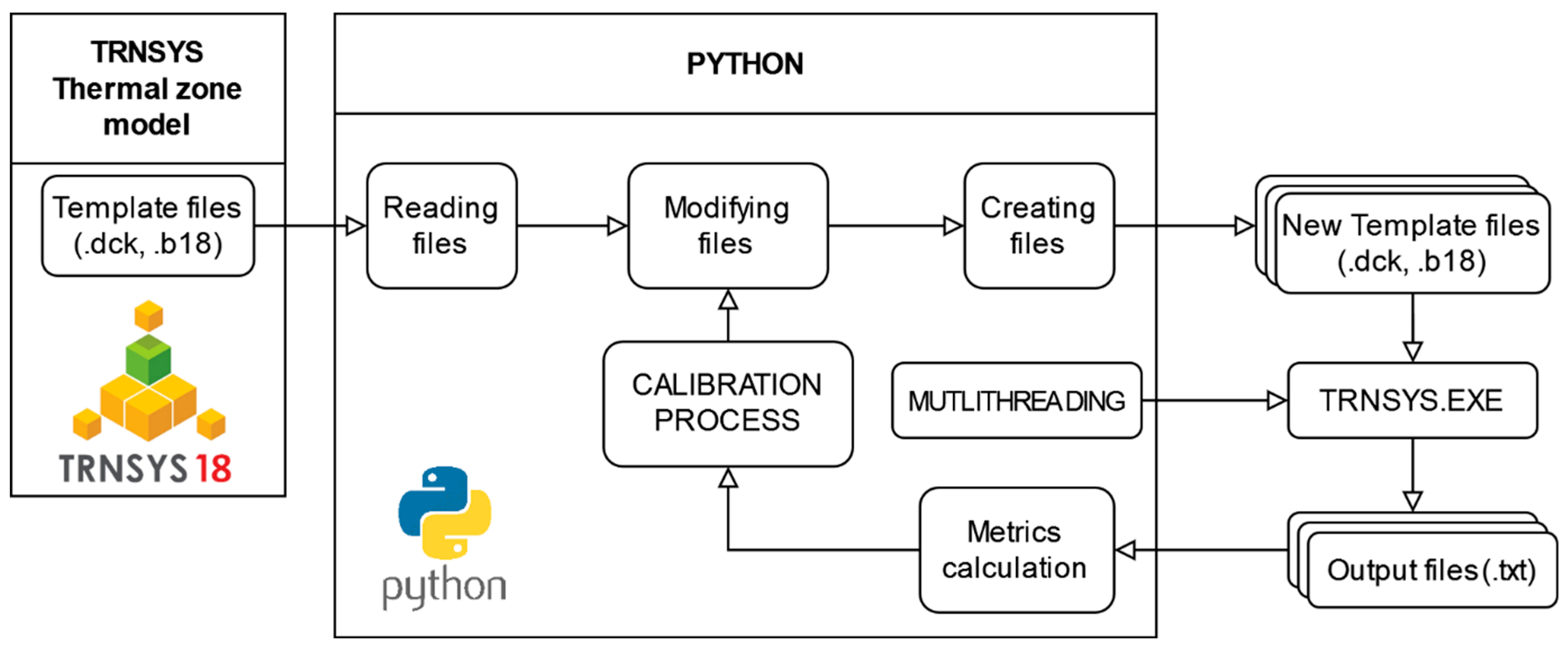
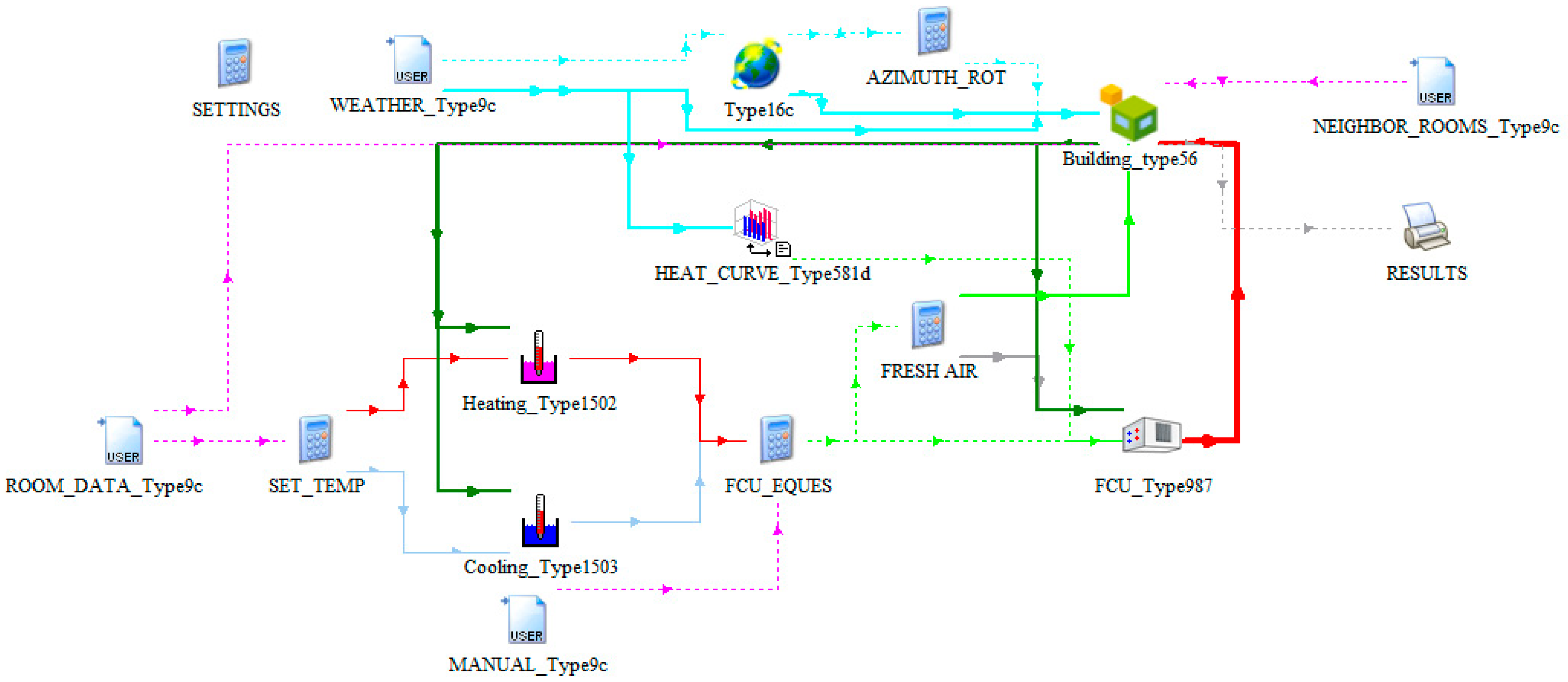
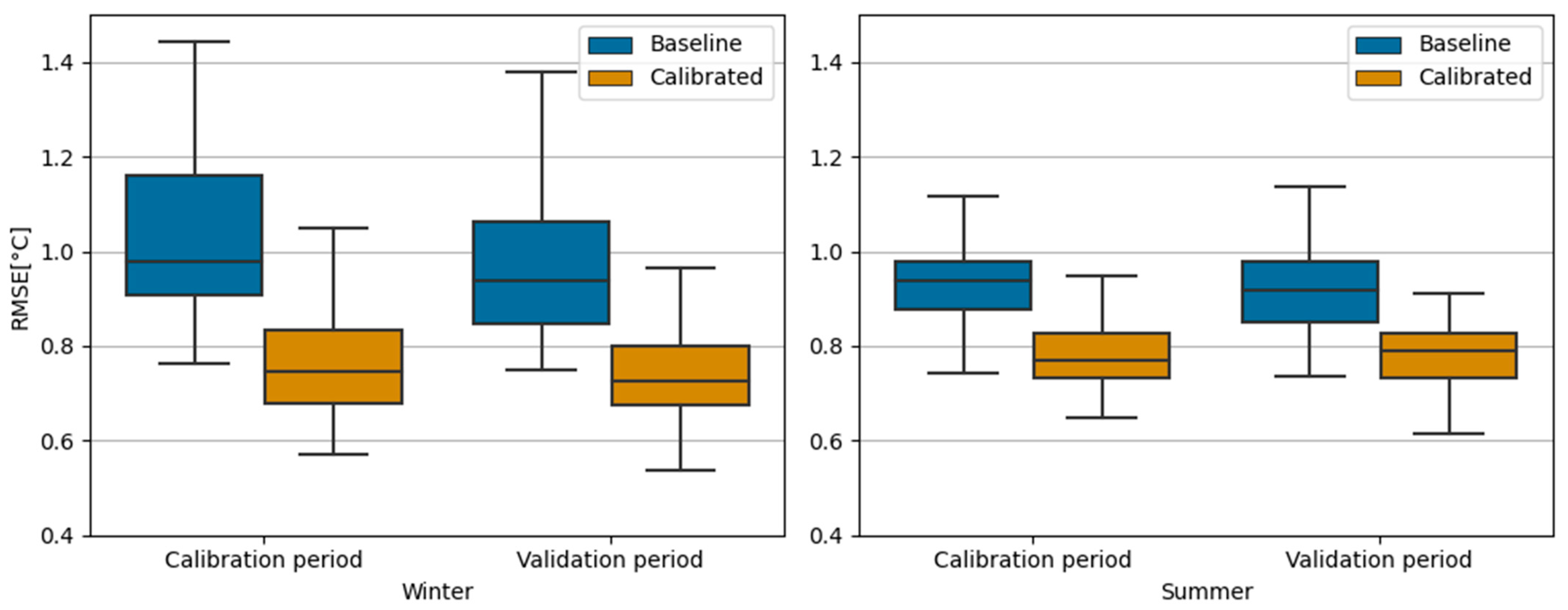
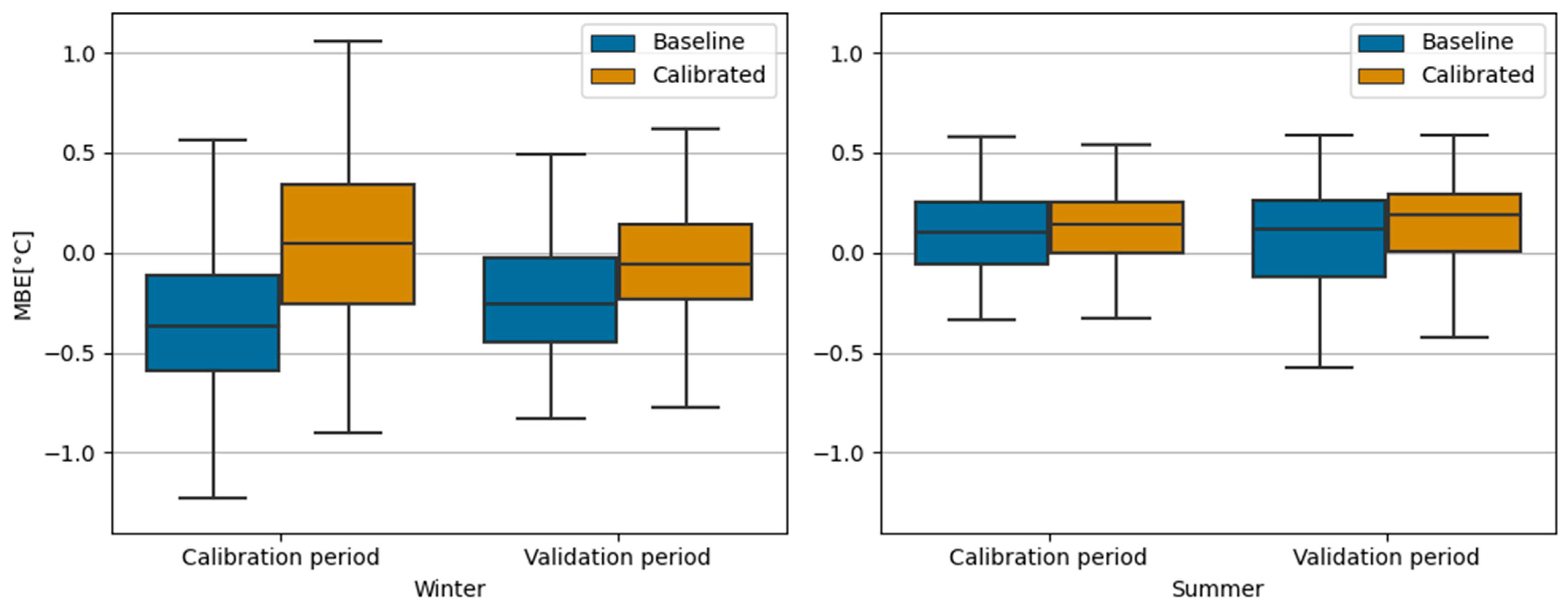
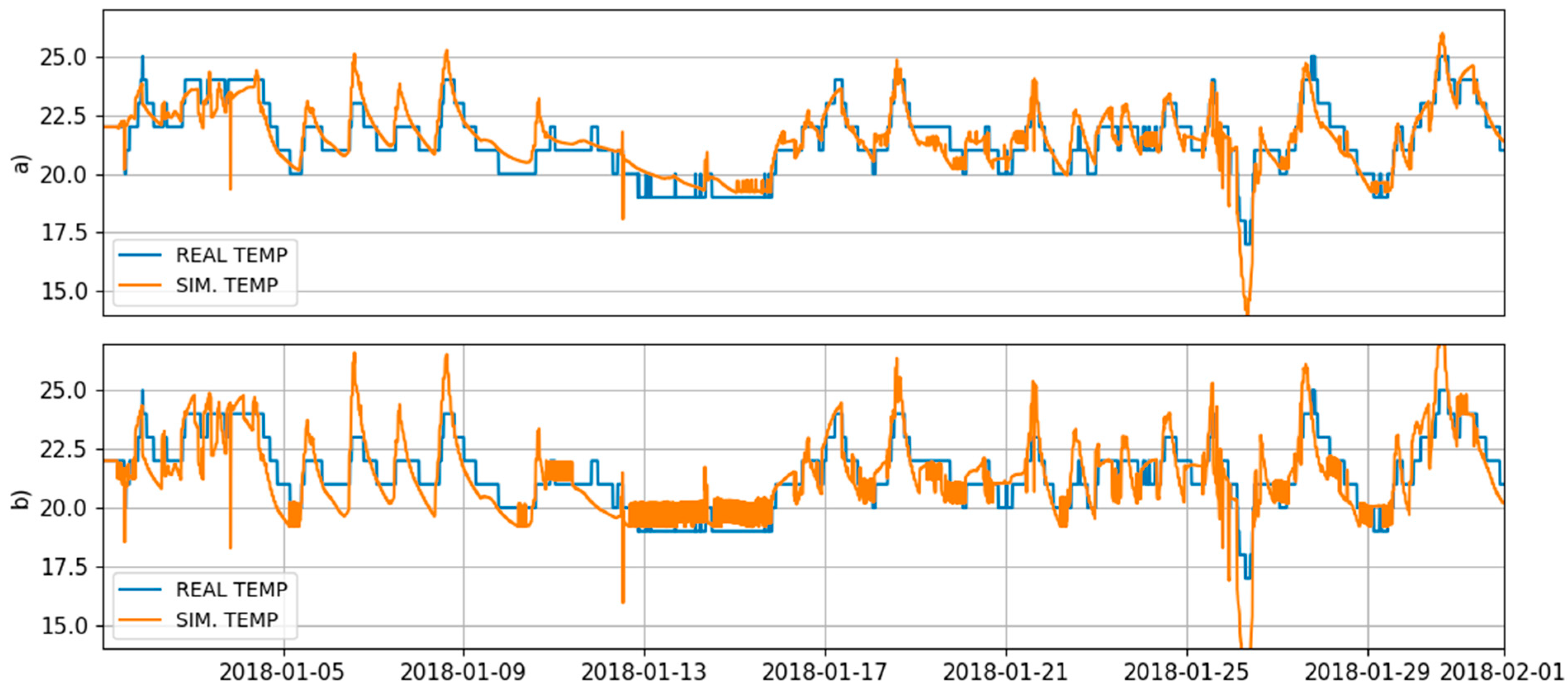
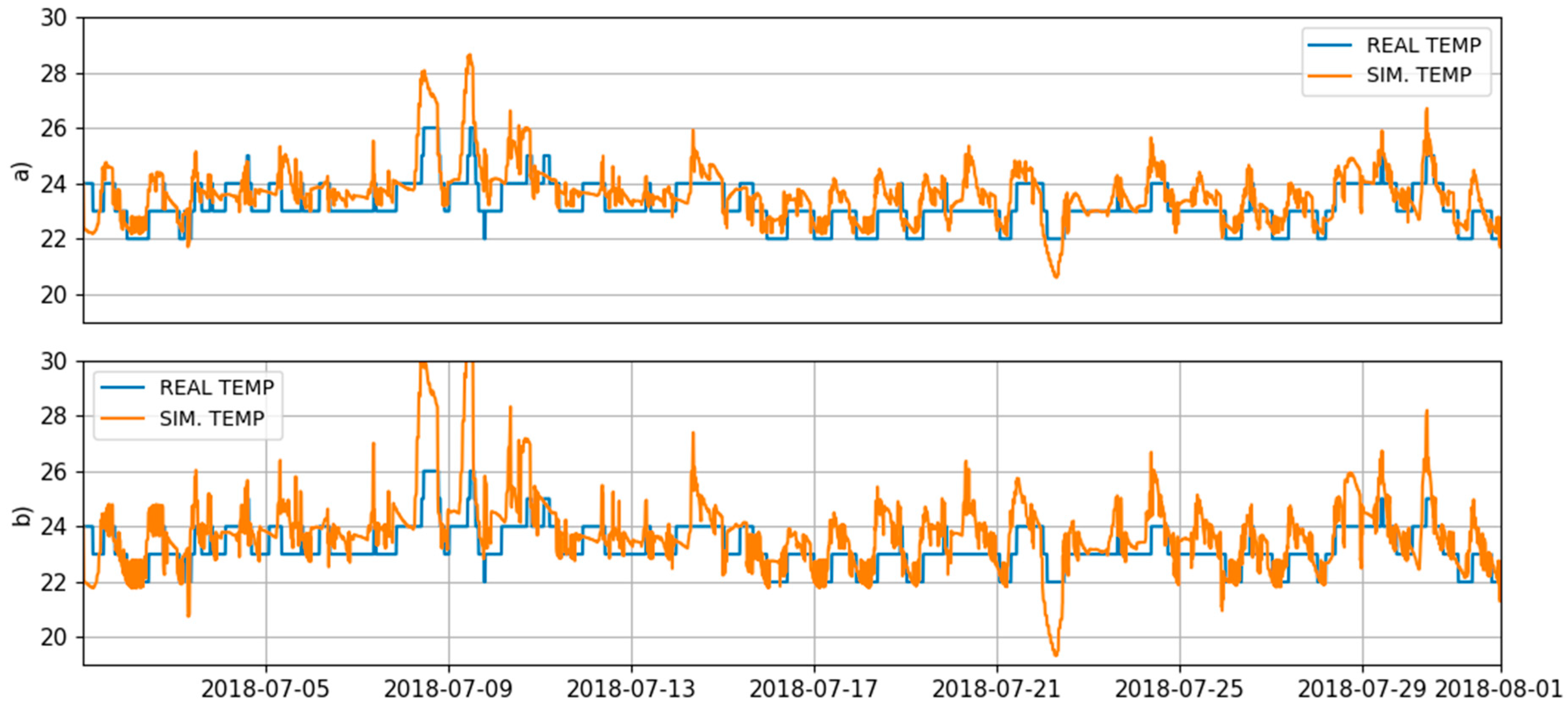
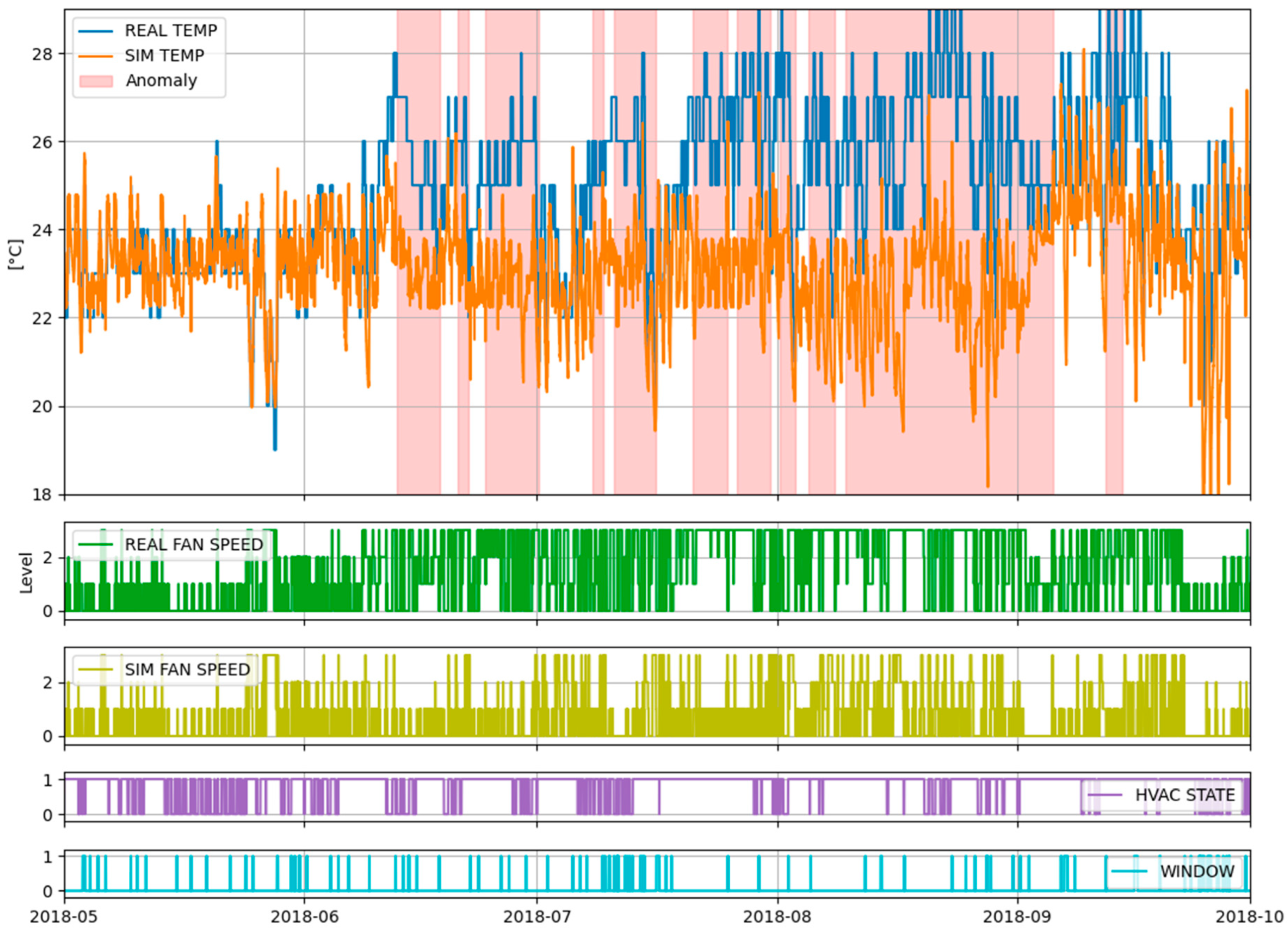
| Elements | Material | δ [m] | λ [W/(mK)] | c [kJ/(kgK)] | ρ [kg/m3] | A [m2] |
|---|---|---|---|---|---|---|
| Ceiling /Floor | Plasterboard | 0.020 | 0.250 | 0.90 | 900 | 26.04 |
| Air gap | 0.300 | 1.310 | 1 | 1 | ||
| Reinforced concrete | 0.300 | 2.500 | 1 | 2500 | ||
| Air gap | 0.125 | 0.570 | 1 | 1 | ||
| Wood | 0.030 | 0.180 | 1.60 | 700 | ||
| Adjacent Walls | Plasterboards | 0.075 | 0.250 | 0.90 | 900 | 22.32 |
| Thermal insulation layers | 0.150 | 0.035 | 1.03 | 100 | ||
| External Wall | Plasterboard | 0.030 | 0.250 | 0.90 | 900 | 6.48 |
| Air gap | 0.035 | 0.190 | 1 | 1 | ||
| Thermal insulation layer | 0.120 | 0.035 | 1.03 | 100 | ||
| Air gap | 0.015 | 0.090 | 1 | 1 | ||
| Glass | 0.008 | 1 | 0.75 | 2500 |
| Parameter | Value |
|---|---|
| Air flow rate | 265/460/552 kg/h |
| Water flow rate | 68 kg/h (heating)/345 kg/h (cooling) |
| Supply water temperature | 70 °C at −15 °C (heating)/9 °C (cooling) |
| Variable | Type | Description |
|---|---|---|
| SET TEMP. | Integer [°C] | Temperature set by guest or hotel staff |
| ROOM TEMP. | Integer [°C] | Measured room air temperature |
| HVAC SPEED | Integer [0–3] | FCU fan speed |
| HVAC STATE | Boolean | FCU status (on/off) |
| HVAC MODE | Boolean | FCU heating or cooling mode (on/off) |
| OCCUPANCY | Boolean | Presence of people in the room |
| WINDOW | Boolean | Window status (open/closed) |
| Variable | Description |
|---|---|
| OUTSIDE TEMP. | Outdoor air temperature, °C |
| IRRADIANCE | Solar irradiation on horizontal surface, W/m2 |
| HUMIDITY | Relative humidity of outdoor air, % |
| Parameter | Value |
|---|---|
| Internal heat gain | 100 W per person [43] |
| Internal moisture gain | 35 g/h per person [43] |
| Infiltration | 0.1 air changes per hour (3 ach when windows are open) |
| Ventilation | Recirculating air + fresh air supplied and extracted at a rate of 60 m3/h |
| Process | Season | Period |
|---|---|---|
| Calibration | Winter | 1 January 2018–31 January 2018 |
| Summer | 1 July 2018–31 July 2018 | |
| Validation | Winter | 1 December 2018–31 December 2018 |
| Summer | 1 August 2018–31 August 2018 |
| Calibration | Validation | |||||
|---|---|---|---|---|---|---|
| Baseline m. | Calibrated m. | Improvement | Baseline m. | Calibrated m. | Improvement | |
| cvRMSE | 4.60% | 3.59% | +22% | 4.40% | 3.56% | +19% |
| RMSE | 1.01 °C | 0.79 °C | +22% | 0.98 °C | 0.79 °C | +19% |
| nMBE | −0.66% | 0.38% | +42% | −0.37% | 0.15% | +59% |
| MBE | −0.14 °C | 0.08 °C | +43% | −0.09 °C | 0.03 °C | +67% |
Disclaimer/Publisher’s Note: The statements, opinions and data contained in all publications are solely those of the individual author(s) and contributor(s) and not of MDPI and/or the editor(s). MDPI and/or the editor(s) disclaim responsibility for any injury to people or property resulting from any ideas, methods, instructions or products referred to in the content. |
© 2023 by the authors. Licensee MDPI, Basel, Switzerland. This article is an open access article distributed under the terms and conditions of the Creative Commons Attribution (CC BY) license (https://creativecommons.org/licenses/by/4.0/).
Share and Cite
Palaić, D.; Štajduhar, I.; Ljubic, S.; Wolf, I. Development, Calibration, and Validation of a Simulation Model for Indoor Temperature Prediction and HVAC System Fault Detection. Buildings 2023, 13, 1388. https://doi.org/10.3390/buildings13061388
Palaić D, Štajduhar I, Ljubic S, Wolf I. Development, Calibration, and Validation of a Simulation Model for Indoor Temperature Prediction and HVAC System Fault Detection. Buildings. 2023; 13(6):1388. https://doi.org/10.3390/buildings13061388
Chicago/Turabian StylePalaić, Darko, Ivan Štajduhar, Sandi Ljubic, and Igor Wolf. 2023. "Development, Calibration, and Validation of a Simulation Model for Indoor Temperature Prediction and HVAC System Fault Detection" Buildings 13, no. 6: 1388. https://doi.org/10.3390/buildings13061388
APA StylePalaić, D., Štajduhar, I., Ljubic, S., & Wolf, I. (2023). Development, Calibration, and Validation of a Simulation Model for Indoor Temperature Prediction and HVAC System Fault Detection. Buildings, 13(6), 1388. https://doi.org/10.3390/buildings13061388








